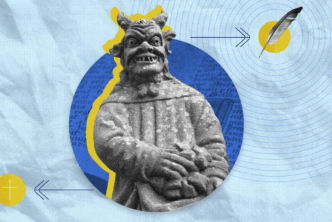In this excerpt from Baptism: A Guide from Life to Death, Peter J. Leithart explores the meaning of baptism and how those baptized form a beautiful picture of Jesus and a “present-tense” sign of the gospel—the good news that he has arrived in the world.
***
The apostles read the Old Testament as a preview of Jesus, full of blurry snapshots of the coming Savior. Jesus is the last Adam (Rom 5:12–21). He’s the seed of Abraham, a resurrected Isaac (Heb 11:17–19), the living temple of God (John 1:14; 2:13–22), the son of David (Rom 1:1–4), a prophet like Moses who leads his people in a new exodus from the Egypt of sin and death (Luke 9:31; Acts 3:22; 7:37). Jesus is the key to all the puzzling riddles of the Old Testament. The second-century Greek bishop Irenaeus used a beautiful image to explain this: the Old Testament contains the fragments of a mosaic; when you put all the pieces together, the mosaic portrays the face of a handsome prince, Jesus, the Prince of Peace.1 The church fathers called the Old Testament fragments “types” (from the Greek, typoi) and saw Jesus as the fulfillment or “antitype” that pulled all the pieces together.2
The baptism of Jesus
This has everything to do with baptism. Jesus’ baptism is the primary baptism. In a sense, it is the one and only baptism. Every other baptism unites us to the baptism of Jesus. That’s why the apostles found blurry snapshots of baptism in the Old Testament, along with snapshots of Jesus. Like Jesus himself, baptism gathers together all the great events and characters of the Bible. Baptism makes us living epistles of God, full of his living words.
Baptism is the reality prefigured by the waters of creation and Eden, Noah’s flood (1 Pet 3:18–22), and Israel’s exodus through the sea (1 Cor 10:1–5). The church fathers found types of baptism in Joshua’s river-passage into Canaan, Elijah’s drenched sacrifice, Elisha’s floating axe head, the cleansing of the Syrian commander Naaman, and Jesus’ healing of the lame man at Bethsaida and of the man born blind.3 Jesus arranges all the shiny fragments of the mosaic into a beautiful picture. When we’re baptized to become members of the “whole Christ,” all the pieces of Jesus’ portrait become part of our portrait. All the types that prefigure Jesus also prefigure the baptized.
Augustine explains the distinction between the old and new covenants with a grammatical illustration. Using the future tense, we say, “The Messiah will be raised.” In the perfect tense, we say, “The Messiah has been raised.” The root word is identical; the two phrases refer to the same reality. In Latin, the ending is the only thing that changes, but that tiny alteration of form generates a momentous shift in meaning, the difference between “I hope for a new life” and “I’ve started a new life.”4
Biblical rites are like root words of a language. All of them share a common meaning. All of them signify God’s promises, which are fulfilled in Jesus. Jesus is the meaning of every biblical ritual, but the form of the rituals varies with the times. As a future-tense rite, circumcision signified Israel’s hope for the Messiah’s advent and triumph. As a present-tense sign, baptism announces the Messiah has come. Jesus is the word of promise, conjugated by the rites of Israel and the Church.
The meaning of baptism
Baptism is a present-tense sign of the gospel, the good news that Irenaeus’s prince has arrived in the world. And so baptism makes a claim about the world. It tells us we don’t live in the world of Abraham, Moses, David, or Jeremiah. We live in a new world and a new time, the world of King Jesus, who rules in the age we call AD (Anno Domini, “Year of our Lord”). The mere fact that Christian baptism cascades over planet Earth tells us something has happened to the world, the happening we call Jesus. Baptism shouts, “The time is fulfilled! The kingdom has come!” It tells us that Jesus and the Spirit have completed, and are completing, all that the Father promised (2 Cor 1:20–22), restoring the world to the harmony of peace. Baptism is the sign of all of this. It heralds a new time.
Baptism doesn’t just picture an announcement. Baptism announces. It doesn’t portray preaching; it preaches. Prophets compared the coming kingdom to a bursting spring of living water (Isa 44:3), a flood of gentiles bearing gifts (Isa 66:12), a cleansing fountain (Zech 13:1). As baptismal water gushes across the globe, God declares these promises fulfilled. Baptism is the gospel, good news from a distant land (Prov 25:25).5
The gospel in baptism
Baptism preaches because it’s God’s work. Baptism isn’t simply water, nor water poured, nor water over which a Trinitarian formula is intoned. Baptism is an act of the Church, using water in the name of the Trinity to bathe a person entering the Church. Because Jesus commands baptism, it is an act of God.6
The hand that dunks or pours is the hand of the minister, but the Spirit baptizes us into the one body (1 Cor 12:12–13). When the rite is done, the baptized person isn’t just wet. He or she is baptized, by God.
At every baptism, God himself preaches the good news of his Son. Every baptized person is a fresh announcement of God’s promise, commissioned to proclaim the good news.
At every baptism, God himself preaches the good news of his Son. Every baptized person is a fresh announcement of God’s promise, commissioned to proclaim the good news. —Peter J. Leithart Share on XBaptism preaches whether or not anyone believes it. God heralds good news at every baptism. Baptism is a ritual clock. It tells the world’s time—“The kingdom is come! The time is fulfilled!”—even if no one sets his watch by it. Baptism does what it’s designed to do—announcing the new time of the gospel—simply by being done.7
Baptism is more than an announcement. It’s an effective announcement. Christians have always denied that baptism is a mere or empty sign. No “naked signs,” Reformer John Calvin insists.8 As God preaches in baptism, he makes the gospel visible, earthly, and real.
Baptized into one body
Let’s think about this by considering circumcision. Yahweh told Abraham to circumcise the males of his household as bearers of promise (Gen 17:9–27). By circumcision and covenant, Abraham’s family was separated from the nations and promised gifts of land and seed, so that Abraham’s family would eventually bless the nations (Gen 12:1–3). At every circumcision, Israel’s vocation was inscribed in flesh.
Jesus fulfills Yahweh’s promise to Abraham. He shatters the wall between Jew and gentile (Eph 2:11–22) so that God’s blessing immerses the nations. Baptism doesn’t just picture what Jesus has done in uniting Jews and gentiles in one body. Baptism unites them. Every converted Jew is washed; every converted gentile is washed. Every man is washed, and every woman. At baptism, the Spirit knits all peoples into one body, blessed with the blessing of Abraham (Eph 4:4–6). The good news of Jesus, who fulfills the promise to Abraham, comes true at every baptism.
By the same token, baptism doesn’t announce a new priesthood somewhere. It is an initiation rite for priests, and it forms the priesthood. Baptism doesn’t just portray a new Israel following a new Joshua into battle; it musters the new-Israel army.9
Through baptism (and preaching, confession and absolution, the Supper, and the communion of saints), the gospel takes a local habitation. Through baptism, salvation takes form as the Church. Baptism retunes discordant humanity. Every baptism proclaims good news to the world and makes that good news real.
The sign of baptism
Baptism is, of course, good news to baptized individuals—the good news of forgiveness, cleansing, justification, sanctification, and glorification. For individuals, as for the world, baptism is a sign, but it’s more than a sign. That “more” is often captured by the term “seal.”10
A seal is a mark of ownership and identity. None of us is autonomous. As our very names attest, we all belong to someone. A seal tells us who we are by telling us to whom we belong. Early Christians compared the “seal” (Greek, sphragis) of baptism to a brand on an animal,11a mark on a slave,12 or a regimental tattoo on a Roman soldier.13 Sealed with the Triune name, the baptized belongs to the Triune God. God seals him or her as a member of the flock of God, a servant in the Father’s house, a warrior under the command of King Jesus.
Baptism tells us we don’t belong to ourselves (1 Cor 6:19–20), but it doesn’t merely tell us. It makes it so. In baptism, God redeems us from the devil’s prison to the free family of Jesus and raises us from the grave to resurrection life. Baptism is a transfer of ownership from the world to the church.
Seals impose demands. Sheep must follow the shepherd. Slaves obey their master. Soldiers must be ready to fight and die. Seals are also promises. Good shepherds care for their sheep. Good masters love their slaves. Good generals provide for their troops. Sealed with baptism, we are taken from the old and brought into the new.
As baptism announces the gospel, it plunges the baptized into the reality of the gospel. Because baptism seals, it saves, because belonging to God is being saved.
***
In Baptism: A Guide to Life from Death, a soul-stirring entry in the Christian Essentials series, Peter Leithart reunifies a Church divided by baptism. In conversation with Scripture and Christian tradition, he explores the meaning of baptism and recovers the baptismal imagination of the Bible—and shows how the waters of baptism can unite us all.
Get Baptism: A Guide to Life from Death today.
Related articles
Related resources
- Classic Studies on Baptism (42 vols.)
- Practicing Baptism: Christian Practices and the Presence of Christ by Bård Eirik Hallesby Norheim
- Believer’s Baptism: The Covenant Sign of the New Age in Christ by Thomas Schreiner and Shawn Wright
- Jack W. Cottrell on Grace and Baptism (2 Courses)
- Problems in Bible Interpretation: Why Do Christians Disagree about Baptism (Course)
- Irenaeus, Against the Heresies 1.8.1
- Christian teachers often compare and contrast Israel’s rituals (like circumcision) with the Christian rite of baptism. According to Thomas Aquinas, circumcision removed a bit of skin, while baptism strips off the flesh that works immorality, impurity, idolatry, strife, anger, and envy. Circumcision was for Israel alone, while baptism is for all nations. Baptism is universal because it contains the “perfection of salvation,” while circumcision signified the perfection that would come through the Jewish Messiah. Circumcision bestowed grace, but not as baptism does. Circumcision foreshadowed a future passion. Baptism’s superior power flows from Christ’s finished passion (Summa Theologiae 3.70.1–4).
- Jean Danielou, The Bible and the Liturgy (South Bend, IN: University of Notre Dame Press, 1956). Medieval scholastics are less poetic, but they discuss the “Sacraments of the Old Law” before examining the “Sacraments of the New Law.” Protestants follow a similar method using the categories of old and new covenants.
- Augustine, Answer to Faustus 19.16. See my “Conjugating the Rites: Old and New in Augustine’s Theory of Signs,” Calvin Theological Journal 34 (1999): 136–47.
- Robert Kolb, Making Disciples, Baptizing: God’s Gift of New Life and Christian Witness (St Louis: Concordia Seminary, 1997), 13. Luther notes that circumcision is sometimes called “covenant,” and he concludes baptism can be described as “new covenant.” Circumcision was a “sign or covenant (signum seu pactum) entrusted to Abraham” (quoted in Jonathan D. Trigg, Baptism in the Theology of Martin Luther [Leiden: Brill, 1994], 39).
- Gregory of Nyssa, On the Baptism of Christ. Writing in Against the Donatists (5), fourth-century bishop Optatus says baptism cannot be repeated because God himself does the washing. Fifth-century bishop of Constantinople John Chrysostom says the whole Trinity acts in baptism (Baptismal Homilies 2.26). Many writers make the same point.
- The technical term for this is ex opera operato, “by the work worked,” though I am using the phrase in an unusual sense. Most Protestants reject the view that baptism is effective ex opere operato, insisting the baptized aren’t automatically saved but must receive Jesus in faith. Historically, though, the phrase has other meanings. For Augustine, ex opere operato is an anti-Donatist motto: baptism’s validity doesn’t depend on the moral character of the minister who baptizes (On Baptism, Against the Donatists). Most Protestants agree with Augustine on that point. Most also affirm ex opere operato in other respects, too. Though Luther rejects the phrase, Trigg observes that he often writes as if baptism’s effect is “automatic” (Trigg, Baptism in the Theology of Martin Luther, 77), and Reformed Protestants believe the rite of baptism automatically makes us members of the “visible church.” See my Priesthood of the Plebs: A Theology of Baptism (Eugene, OR: Wipf & Stock, 2003), 158–60.
- Institutes 4.17.10.
- Heinrich Bullinger makes the point strongly: “We openly profess that we have sacraments which are holy, and not profane; effectual, and not without force; garnished from above, not naked; and therefore they are full, not void or empty” (Decades, Fifth Decade, Sermon 8). According to Bullinger, God instituted the sacraments for the godly, and for the godly they are effective.
- Heidelberg Catechism, Lord’s Day 25, q. 66; Westminster Confession of Faith 27.1. The term is ancient. Ephrem the Syrian compares baptismal anointing and the Spirit to the seal of an official’s signet ring (Hymns 7.6). Baptism is sometimes a seal, sometimes the means by which the Spirit seals our souls (2 Cor 1:22; Eph 1:13; 4:30). For the latter, see Cyril of Jerusalem, Mystagogical Lectures 16.24. See Jean Danielou, The Bible and the Liturgy, ch. 3.
- Gregory Nazianzen wrote, “A sheep that is sealed is not easily snared, but that which is unmarked is an easy prey to thieves” (Oration 40, on Baptism 15).
- Ambrose of Milan: “Slaves are marked with the sign of their master” (quoted in Danielou, Bible and Liturgy, 59).
- The newly baptized, writes Gregory Nazianzen, is “like a young soldier who has just been given a place among the athletes, but has not yet proved his worth as a solider” (quoted in Danielou, Bible and Liturgy, 58).






